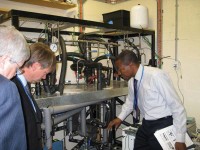 If you are looking for cooling technology that use natural working fluids with low GWP/ODP and makes use of waste or recovered heat or even solar energy, Adsorption could be something to watch out for.
If you are looking for cooling technology that use natural working fluids with low GWP/ODP and makes use of waste or recovered heat or even solar energy, Adsorption could be something to watch out for.
The SIRAC (Sustainable Innovation in Refrigeration and Air Conditioning) network met at the University of Warwick, Centre for Sustainable Energy Engineering and Design in May to review some innovative applications in adsorption technology. Adsorption is a heat driven cooling process. It uses an adsorption medium such as activated carbon together with a secondary refrigerant to achieve a cooling effect. The Head of the Centre, and leading researcher in this area, Prof Bob Critoph explained that Adsorption uses a chemical rather than a mechanical compressor and is driven by heat rather than mechanical work. The operation of adsorption heat pumps and refrigerators is based on the ability of porous solids (the adsorbent) to adsorb vapour (the adsorbate or refrigerant) when at low temperature and desorb it when heated.
 Although the heating and cooling provided by a single generator is discontinuous, it can be made continuous by operating two or more generators out of phase.
Although the heating and cooling provided by a single generator is discontinuous, it can be made continuous by operating two or more generators out of phase.
Adsorption has many potential applications in refrigeration, airconditioning and heat pumps. Researchers at Warwick gave detailed presentations and demonstrations of working rigs for vehicle air conditioning from waste engine heat; domestic gas fired heat pumps; and solar or biomass powered refrigeration and air conditioning. These prototypes are in development for a number of applications and field trials are taking place.
But the technology has a few challenges to overcome before you will see an adsorption based system on the shelves at the wholesaler! The basic adsorption cycle has low efficiency, although recovery of heat between adsorbent beds can give good performance. Low thermal conductivity of available adsorbent materials can lead to large sized equipment but innovative heat exchanger designs can overcome this problem. Research work is now focused on improving performance in these two areas.
 For more information about the work of the University of Warwick Sustainable Energy Engineering and Design group presented at the SIRAC meeting and to find out about future meetings see www.sirac.org.uk
For more information about the work of the University of Warwick Sustainable Energy Engineering and Design group presented at the SIRAC meeting and to find out about future meetings see www.sirac.org.uk




Comments are closed.